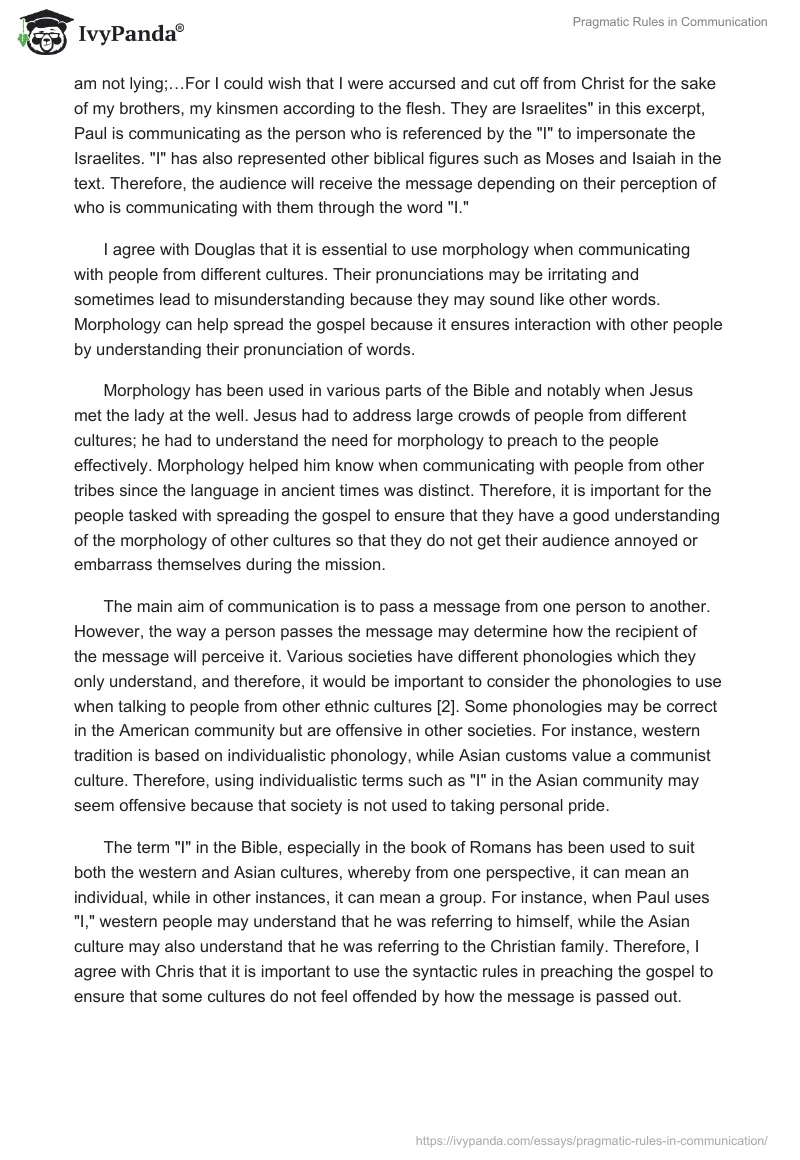Every community has its common language and communication rules which direct them towards appropriate and inappropriate communication called community speech. Pragmatic rules show how social language can be used to produce either a positive or negative meaning. They enable a person to know what combination of words to whom under what circumstances. Pragmatic rules between the west and the east commonly differ due to their differences in culture and lifestyles.
The west consists of capitalist countries that insist on individualistic nature. On the other hand, the east commonly relies on communism, whereby most of their language is based on community and not the individual. Therefore, a person from the west may have different pragmatic rules than a person in the east because of the nature of their cultures. There are three pragmatic factors in verbal communication: locution, illocution, and perlocution. Locution is the literal meaning of the word that is found in the dictionary. Illocution is the intention of the speaker on the message that the word is supposed to avail. Percolation is the meaning that the receiver of the message gets from the news. In most cases, communication between people from the west and the east may bring positive or negative impacts based on the three different scenarios.
An example is the use of the word howlee in the west and the east. Early missionaries used Howlee as a slang word to imply a person who howls a lot. However, Howlee means an outsider from a certain group in Japanese culture. This is the common meaning for Howlee in Japan used by the inhabitants. However, there is a third meaning of Howleee to show honorary status. These three scenarios create locution, illocution, and perlocution, depending on how they are used. A lifeguard sees a tourist who drops off his surfboard and is loudly lamenting. He therefore comes and asks him, “what is the problem, Howlee?” This creates a negative impression on the visitor because he considers the word as a sign of disrespect and threats. The tourist may understand howlee as an “Outsider,” which may bring a negative impression. On the other hand, the lifeguard may have used the word to mean why he is “crying” or with a positive meaning of “honored guest.”
The use of “I” in the Bible has also been pragmatic. In various instances, “I” has been confused about whom the “I” is referring to. “I am speaking the truth in Christ—I am not lying;…For I could wish that I were accursed and cut off from Christ for the sake of my brothers, my kinsmen according to the flesh. They are Israelites” in this excerpt, Paul is communicating as the person who is referenced by the “I” to impersonate the Israelites. “I” has also represented other biblical figures such as Moses and Isaiah in the text. Therefore, the audience will receive the message depending on their perception of who is communicating with them through the word “I.”
I agree with Douglas that it is essential to use morphology when communicating with people from different cultures. Their pronunciations may be irritating and sometimes lead to misunderstanding because they may sound like other words. Morphology can help spread the gospel because it ensures interaction with other people by understanding their pronunciation of words.
Morphology has been used in various parts of the Bible and notably when Jesus met the lady at the well. Jesus had to address large crowds of people from different cultures; he had to understand the need for morphology to preach to the people effectively. Morphology helped him know when communicating with people from other tribes since the language in ancient times was distinct. Therefore, it is important for the people tasked with spreading the gospel to ensure that they have a good understanding of the morphology of other cultures so that they do not get their audience annoyed or embarrass themselves during the mission.
The main aim of communication is to pass a message from one person to another. However, the way a person passes the message may determine how the recipient of the message will perceive it. Various societies have different phonologies which they only understand, and therefore, it would be important to consider the phonologies to use when talking to people from other ethnic cultures [2]. Some phonologies may be correct in the American community but are offensive in other societies. For instance, western tradition is based on individualistic phonology, while Asian customs value a communist culture. Therefore, using individualistic terms such as “I” in the Asian community may seem offensive because that society is not used to taking personal pride.
The term “I” in the Bible, especially in the book of Romans has been used to suit both the western and Asian cultures, whereby from one perspective, it can mean an individual, while in other instances, it can mean a group. For instance, when Paul uses “I,” western people may understand that he was referring to himself, while the Asian culture may also understand that he was referring to the Christian family. Therefore, I agree with Chris that it is important to use the syntactic rules in preaching the gospel to ensure that some cultures do not feel offended by how the message is passed out.
Bibliography
Ramsey, S. R. (1989). The languages of China. Princeton University Press.
Ting-Toomey, Stella, and Leeva C Chung. 2012. Understanding Intercultural Communication. 2nd ed. New York: Oxford University Press.


